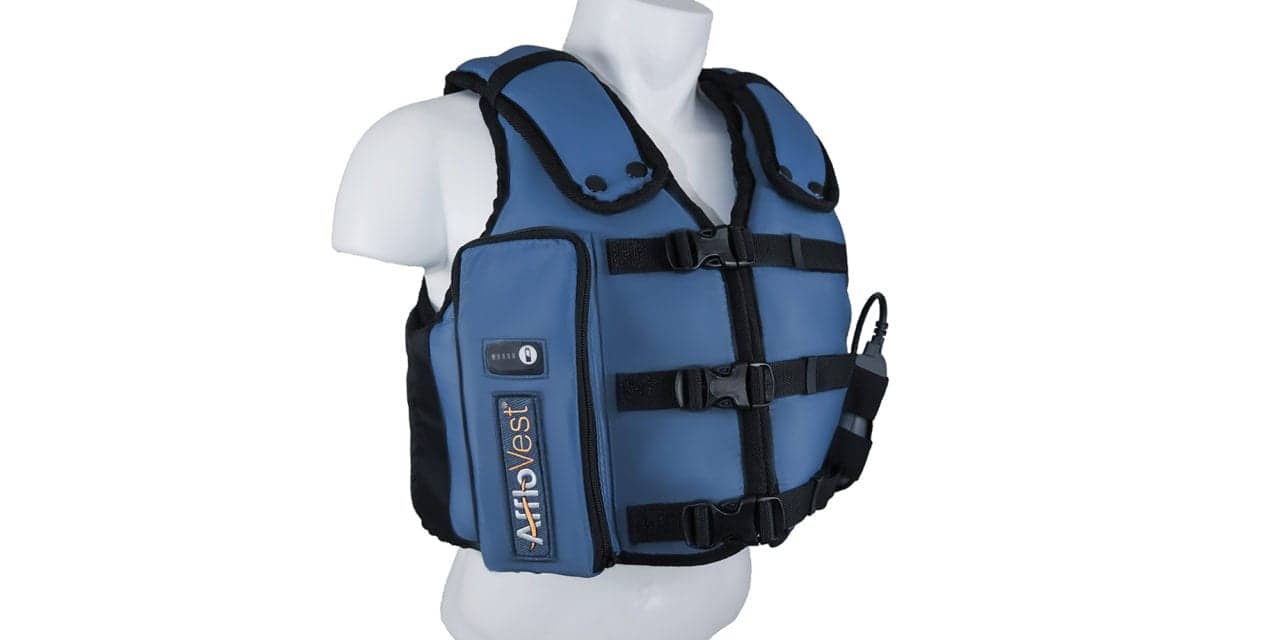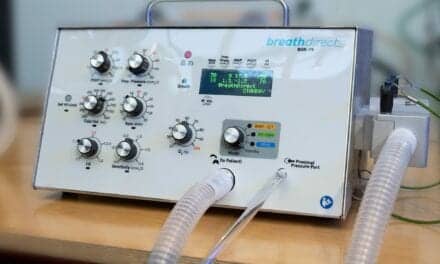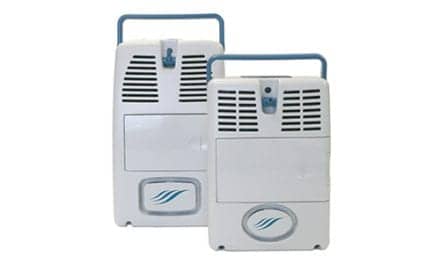This independent, randomized study compared available HFCWO vests in order to assess patient preference and perceived efficacy in several key categories.
By i Michelle Wetherby, MS, i Nicole Dunn, MBA, RRT, ii Vanessa Mullenix, and ii Rosemary Sundin
This content is sponsored by Tactile Medical.
Background
Airway clearance techniques (ACT) are commonly recommended to eliminate bronchial secretions in patients with a wide variety of respiratory and neuromuscular disorders. The aim of these ACT is to reduce airway obstruction caused by secretions and prevent or decrease the likelihood of respiratory tract infections and to prevent or reverse atelectasis.
Several ACT techniques have been well studied and found to benefit patients in need of assistance with secretion clearance. These include coughing or huffing, active cycle of breathing technique (ACBT), autogenic drainage (AD), chest physical therapy (CPT) or postural drainage and percussion, positive expiratory pressure (PEP), and oscillating positive expiratory pressure (OPEP).
In addition to these modalities, various chest wall oscillation devices are available to these patients. The first was released in 1988 and demonstrated statistically significant improvement in forced vital capacity (FVC) and forced expiratory volume in 1 second (FEV1) in cystic fibrosis patients using high frequency chest compression therapy as compared to manual chest physical therapy.
Since that time, the class of therapy has evolved and several manufacturers have released iterative versions of vests designed to apply pressure and oscillate the lungs, facilitating the elimination of bronchial secretions. The evolved therapy has been coined high frequency chest wall oscillation (HFCWO) and several vests are currently available to patients via prescription.
Several vests, including the Electromed Smartvest, Hillrom The Vest, and Philips InCourage vests, are bladder style vests consisting of a compressor that is attached to the vest via hoses and requires an electricity source for device use. The controller and hoses inflate air chambers in the vest that oscillate to provide therapy.
By contrast, the Tactile Medical Inc AffloVest utilizes eight anatomically positioned oscillating motors designed to target all lobes of the lung, front and back, and delivers percussive force to loosen secretions. The AffloVest is battery operated, allowing users to be fully mobile during airway clearance treatments. The AffloVest has been studied extensively in controlled clinical trials showing improvement in lung function and reduced healthcare utilization.
Methods
A study comparing the AffloVest to currently marketed bladder-style vests was undertaken to assess patient preference and perceived efficacy in several key categories. This randomized study was conducted by an independent market research firm. Participants were recruited from the firm’s existing database and included 30 vest-naïve volunteers with a variety of self-reported respiratory conditions. In addition, participants were blinded to the sponsor of the study, and identifying labels were covered to ensure they were also blinded to the brand or name of the vest to which they were randomized.
Nineteen women and 11 men participated in the study. All participants wore the AffloVest and were randomized to either the Smartvest, The Vest, or the InCourage (comparator). Patients were further randomized to the order in which the control vest was worn (first vs second). This study was not conducted under IRB oversight, but participants were required to provide written consent to audio and video recording of their interview.
Once consent was provided, participants were asked to don the first vest per the randomization schema. Proper vest fit was assured by a respiratory therapist who was familiar with all products and knowledgeable regarding application and therapy. Each participant was given instructions according to the manufacturer’s Instructions for Use to operate the vest and wore the first vest for 15 minutes. Following vest operation, participants were asked to doff the vest. Participants were interviewed using standardized, qualitative questions about their experiences from the time they picked up the vest until the vest was removed. The process was then repeated with the second vest.
The patient interview consisted of collecting feedback in the process of donning and doffing, overall fit, controls and features, likelihood of being compliant with the prescribed duration of therapy, overall comfort while wearing, their auditory experience, how they imagine the vest would fit into their lifestyle (including using the vest around others), and their anticipated use while traveling.
Results
When asked, 93% of respondents universally preferred the AffloVest in the categories of comfort, auditory experience, travel, lifestyle and using around others. Overall, 90% of participants stated they believed they would be compliant with once daily therapy and 87% believed they would be compliant if prescribed twice daily therapy sessions. By contrast, none of the participants indicated they would be likely to be compliant with once daily therapy and only 3% of participants stated they would be compliant with twice daily therapy when asked about one of the bladder style vests.
The AffloVest controls and features were preferred by 77% of the participants, 70% preferred the overall fit, and 90% preferred the experience of doffing the AffloVest.
Participants were asked to rate comfort, benefit, and auditory experience on a scale of 1-10 with 1=not at all and 10=very. In every category, participants rated their AffloVest experience higher than the test vest. (See Table 1.) Participants in this study were also asked to share how the vest felt and what sensations they were experiencing.
When wearing the AffloVest they commented on the comfort while wearing, often described a feeling of massage or gentle pounding similar to a handheld massage device. In comparison, the other vests were noted to be uncomfortable, loud, and tight. Participants commented “It sounds like a jackhammer.” “It feels like a blood pressure device on the arm, but on the chest.”
One notable finding of the study was that the order of product trial impacted the perceived benefit of the treatment. Specifically, if the AffloVest was worn second, participants were more likely to comment that the negative experience of the therapy provided by the comparator vest equated to a perception of a more effective therapeutic value often voicing a “no pain, no gain” philosophy.
Despite this perception, 93% of participants stated that they favored the AffloVest and reported a greater likelihood of compliance to the therapy if they were prescribed that vest.

Discussion
Poor adherence to long-term therapy of chronic diseases in developed countries averages 50%. Patients who do not, or cannot, be compliant to long-term treatment have poor health outcomes and increased health care utilization. Patients with airway obstruction caused by bronchial secretions are more likely to develop complications including repeated respiratory tract infections and atelectasis, resulting in an increase in symptoms and health care utilization. For these reasons, it is important for them to have techniques to clear the secretions in a manner that is easy to use and with which they are likely to be compliant, to ensure consistent management of their disease.
An overwhelming number of participants in this study preferred AffloVest over the bladder style HFCWO vests. When asked, 93% of participants reported preferring AffloVest overall, and specifically in comfort, perceived benefit, and auditory experience.
This is critical as patient adherence to prescribed therapy has been shown to have a high correlation to their experience, satisfaction, and, most importantly, their likelihood to be compliant in conducting their therapy.
Conclusions
Patients with chronic conditions have access to more information than ever to inform their decision making when discussing treatment options with their healthcare providers (HCPs). It is critical for chronic respiratory patients to be compliant with airway clearance to reduce the risk of infection and associated health care utilization. The relationship between patient satisfaction and compliance with long-term therapy should be considered when discussing treatment options with patients.
The AffloVest has been shown to provide benefit in a variety of patient populations in several published studies. This study suggests that the AffloVest’s differentiating features of being battery operated, completely portable, quiet, and comfortable are likely to increase compliance to the therapy and providing ongoing benefit to patients and should be considered for patients with increased bronchial secretions.
Michelle Wetherby and Nicole Dunn are employees of Tactile Medical (Minneapolis, MN). Vanessa Mullenix and Rosemary Sundin are employees of Orman Guidance Inc (Edina, MN), which received funding for this research from Tactile Medical. For more information, please contact corresponding author Michelle Wetherby at [email protected].
Author Affiliations
iTactile Medical (Minneapolis, Minn)
iiOrman Guidance Inc (Edina, Minn)
References
- Belli S, Prince I, Savio G, et. al. Airway Clearance Techniques: The Right Choice for the Right Patient. Front Med (Lausanne). 2021;8:544826
- Henderson W. 7 Airway Clearance Techniques. Lung Disease News. 2017 Nov 20.
- Warwick WJ, Hansen LG. The long-term effect of high-frequency chest compression therapy on pulmonary complications of cystic fibrosis. Pediatr Pulmonol. 1991;11(3):265-71.
- AffloVest Clinical Support & Evidence. Updated 2022. Accessed January 24, 2023. https://afflovest.com/resource-center/clinical-papers/
- Kisa A, Sabaté E, Nuño-Solinis R. Adherence to long-term therapies: Evidence for action. WHO Library. 2003. https://www.researchgate.net/publication/318679616_ADHERENCE_TO_LONG-TERM_THERAPIES_Evidence_for_action Accessed 2/3/2023.
- Doyle C, Lennox L, Bell D. A systematic review of evidence on the links between patient experience and clinical safety and effectiveness. BMJ Open. 2013;3:001570.










